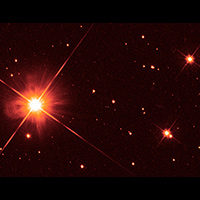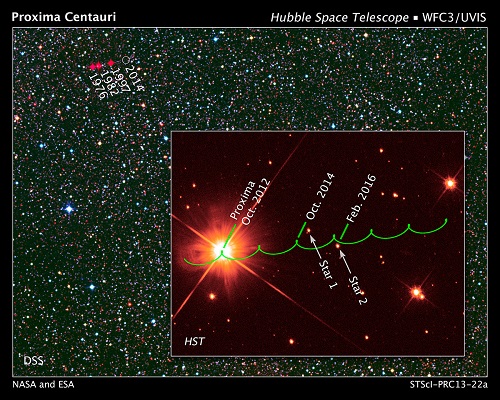
I normally think about gravitational lensing as a way of finding planets that are a long way from home. That’s just the nature of the beast: Lensing as an exoplanet detection tool depends upon a star with planets moving in front of a background object, its mass ‘bending’ space enough to cause slight changes to the image of the farther star. Monitor those changes closely enough and you may see the signature of a second disruption, flagging the presence of a planet around the closer star. Occultations like these are rare enough and more likely to be found in a crowded starfield, such as looking toward galactic center.
It’s a remarkable fact that instruments like the Hubble Space Telescope can make measurements down to 0.2 milliarcseconds, a milliarcsecond being (as this Space Telescope Science Institute news release notes) the angular width of a nickel in Honolulu when viewed from New York City. Comparable measurements, within range of the European Southern Observatory’s Very Large Telescope (Chile) and ESA’s Gaia space telescope, may be able to offer confirmation of what we find when we study two upcoming occultation opportunities involving not a distant star but the closest one.
Image: Proxima Centauri (Alpha Centauri C). Credit: NASA, ESA, K. Sahu and J. Anderson (STScI), H. Bond (STScI and Pennsylvania State University), M. Dominik (University of St. Andrews).
For STScI’s Kailash Sahu has gone to work on stars that have a high angular motion across the sky, reasoning that we might be able to find a nearby star on which to make microlensing observations. In Proxima Centauri, Sahu hit the jackpot, a star that crosses a stretch of sky with the apparent width of the full Moon every 500 years. Not one but two occultation events loom in Proxima’s near-future, the first being its passage in front of a 20th-magnitude background star in October of 2014, the second an occultation of a 19.5-magnitude star in February of 2016.
Reading about this induced one of those ‘slap yourself on the forehead’ moments when I realized how prescient it was of Sahu and team to use Hubble to plot Proxima’s trajectory, looking for precisely this kind of event. And if the instruments above can measure down to 0.2 milliarcseconds, this method could pay off, for the displacement of the background stars induced by Proxima’s mass is estimated at 0.5 milliarcseconds and 1.5 milliarcseconds respectively. If there are planets around Proxima Centauri, this method may find them.

Image: This plot shows the projected motion of the red dwarf star Proxima Centauri (green line) over the next decade, as plotted from Hubble Space Telescope observations. Because of parallax due to Earth’s motion around the Sun, the path appears scalloped. Because Proxima Centauri is the closest star to our Sun (distance, 4.2 light-years), its angular motion across the sky is relatively fast compared to much more distant background stars. This means that in 2014 and 2016 Proxima Centauri will pass in front of two background stars that are along its path. This affords astronomers a rare opportunity to study warping of space by Proxima’s gravity, as will be evident in the apparent displacement of the two stars in sky photographs. This effect is called gravitational lensing. The amount of warping will be used to calculate a precise mass for Proxima Centauri and look for the gravitational footprint and any planets orbiting the star. The background image shows a wider view of the region of sky in the southern constellation Centaurus that Proxima is traversing. Credit: NASA, ESA, K. Sahu and J. Anderson (STScI), H. Bond (STScI and Pennsylvania State University), M. Dominik (University of St. Andrews), and Digitized Sky Survey (STScI/AURA/UKSTU/AAO).
Earlier efforts to find planets around Proxima have been intensive. Work with the UVES spectrograph at the European Southern Observatory, coupled with radial velocity studies of the star from the 1990s, helps us understand what we won’t find around Proxima. No planet of Neptune mass or larger is detectable there out to a distance of 1 AU. And we can go further: No super-Earths larger than 8.5 Earth masses have been found. Within Proxima’s habitable zone (assuming roughly 0.022 to 0.054 AU, which corresponds to an orbital period ranging from 3.6 to 13.8 days), no planets larger than 2-3 Earth masses have been detected in circular orbits.
You can see how much we leave out with this description, including planets of Earth mass or smaller in the habitable zone. And we always have to contend with the limitations of radial velocity work, which is sensitive to the orientation of the planetary system to us — in other words, we don’t know the angle at which we are observing the system, so we wind up with the still faint possibility of larger planets if we are seeing the Proxima system face-on. We do know that no transits have been found, indicative of an edge-on orientation, and the upcoming microlensing study coupled with ever more precise radial velocity measurements may help unlock the puzzle.
For more on recent Proxima Centauri work, see Endl and Kürster, “Toward Detection of Terrestrial Planets in the Habitable Zone of Our Closest Neighbor: Proxima Centauri,” Astronomy and Astrophysics, Volume 488, Issue 3, 2008, pp.1149-1153 (abstract). Kailash Sahu will be presenting his findings at the meeting of the American Astronomical Society in Indianapolis, with a paper already submitted to the Astrophysical Journal.



What kind of distance range would this be most sensitive to? Typical microlensing detections are most sensitive to planets near the snow-line around stars which are located at distances of several kiloparsecs, but Proxima is much closer than the lens systems in these events.
Isnt this more strictly what has been called ‘mesolensing’? I seem to remember that the red dwarf VB10 (of the notorious ‘astrometric’ giant planet detection-non-detection a few years back) was supposed to have some similar events coming up. cant remember where I read that.
P
What about using the outer planets to lense on Proxima?
Surely this is also news for METI enthusiasts. If there is a planet round the FAR star, won’t a similar calculation give us an earlier, but perfect time to transmit, or is this not close enough for that degree of lensing.
andy, I would think the angular separation of these passes would dominate the calculation. The image doesn’t show a scale but it looks (?) like the planet would have to be fairly far removed from Proxima, and in an ideal position (of course), to cause a detectable variation of the lensing event.
Mike, you mean our outer planets? They’re far too close to use as a lens. The A Cen system is also well off the ecliptic so you’d have to travel far from Earth to create an alignment.
Rob, lensing in this fashion is reciprocal but you’d be transmitting blind since you do not know if the far star has a planet or where it might be.
Indeed, re Mike’s point, Jupiter’s focal sphere is 1.1 light months out (6100 AU), while Neptune’s is 2.6 light months (13,525 AU). Maccone discusses the possibility of a FOCAL mission looking back at the planets as it reaches these distances and using their own lenses, but they wouldn’t be workable at closer distances. And as Ron points out, Alpha Centauri is not aligned with the ecliptic, so focal alignments are not workable with the outer planets.
Quick calculation suggests the Einstein ring radius is comparable to the angular size of Proxima’s insolation habitable zone, provided the distance to the source star is much further away than Proxima is. By contrast the bulge lensing events that have yielded planet detections have Einstein ring radii comparable to the angular size of the lens star snowlines.
What works for Proxima should also work for lots of other stars that are relatively close by. Say there are a thousand of them, that could make for an event every few days. Should there be a systematic program computing and enumerating such upcoming events?
Also, when these events occur, it is highly beneficial to have multiple telescope look at the same time from different view points. From what I have heard, even two different locations on Earth show a slight, but measurable difference in timing and intensity of lensing. So, should we coordinate multiple space and ground telescopes to all look at the same spot for these events?
La domanda posta da “Eniac” nel precedente intervento, è davvero molto importante, anche se mi rendo conto che fare una simile ricerca, per un unico telescopio ad esso dedicato, non sarà una cosa così semplice, anche per motivi di bilancio.
(Ma, magari, mi sbaglio).
Forse, bisognerebbe creare una rete di piccoli strumenti, utilizzata dagli astrofili in tutto il mondo, questo, potrebbe essere economicamente, più valido.
E poi, vorrei fare una ulteriore considerazione.
Se noi, utilizzando questo metodo di rilevamento, siamo in grado di scoprire pianeti simili al nostro, anche a grande distanza, posso immaginare che anche “altre” intelligenze(se esistono)possono aver rilevato la presenza del nostro pianeta, anche a grande distanza da noi.
Quindi, la nostra esistenza, potrebbe essere già nota non solo entro i limiti raggiunti dalle nostre emissioni radiofoniche e televisive, ma assai più lontano.
E questo, potrebbe aprire alcuni scenari interessanti, ma anche potenzialmente inquietanti, considerando, che non sappiamo chi o cosa “c’è là fuori”…
Un saluto a voi tutti, da Antonio Tavani
And via Google Translate:
The question posed by “Eniac” in the previous intervention, it is really very important, although I realize that making such a search for a single telescope dedicated to it, it will not be such a simple thing, but for budgetary reasons.
(But maybe I’m wrong).
Perhaps we should create a network of small tools, used by amateur astronomers around the world, this could be economically, longer valid.
And then, I would make a further consideration.
If we, using this detection method, we are able to discover planets similar to our own, even at a great distance, I can imagine that “other” intelligences (if any) may have detected the presence of our planet, even at a great distance from us.
Thus, our existence, may already be known not only within the limits reached by our radio and television broadcasts, but much farther away.
And this could open up some interesting scenarios, but also potentially disturbing, considering that we do not know who or what “out there” …
Greetings to you all, by Antonio Tavani
The angular distance on the order of arcsecond between that stars and passing Proxima means that there is a location within the inner Solar system where it will be direct eclipse, and we could use Proxima as a gravitational lens to study the far stars like it was proposed in FOCAL mission, but with even greater focal length. Maybe some kind of Arkyd telescope with ion drive, scanning the lightcurves of Einstein rings some 10s of millions of kms away and deconvoluting the first resolved images of exoplanets in the feb. 2016?…
Also, such probe could obsreve similar events with another stars, like Eniac said, with some kind of script doing the automated search on proper motions and relative positions in the digital sky surveys and predicting the events…